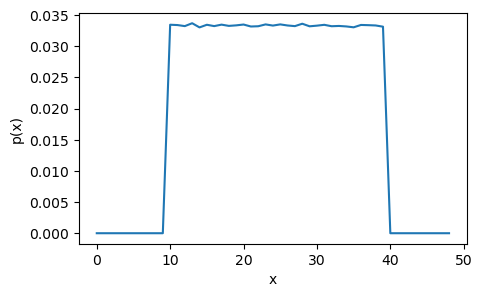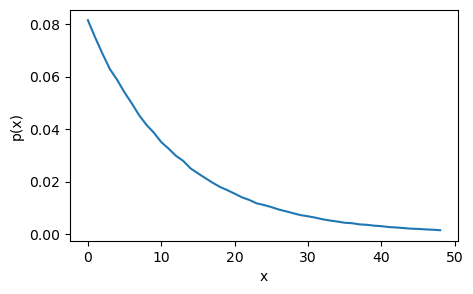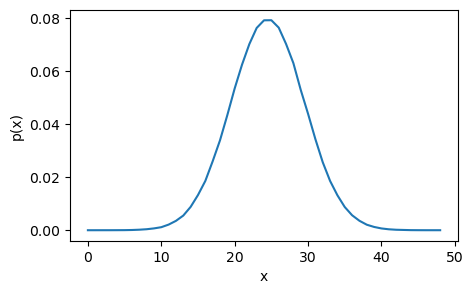Random variables and simulation#
If you are working in simulation modelling in python it is highly likely that you will need to make use of the numpy.random namespace. This provides a variety of statistical distributions that you can use for efficient sampling. Let’s take a look at a few example distributions. For example generating 100,000 samples from the uniform, exponential distributions and normal distributions:
1. Imports#
We will import numpy for our sampling and matplotlib to plot our distributions.
import numpy as np
import matplotlib.pyplot as plt
2. Helper functions#
The simple function below can be used to automatically produce a plot illustrating a distribution of samples.
def distribution_plot(samples, bins=100, figsize=(5,3)):
'''
helper function to visualise the distributions
Params:
-----
samples: np.ndarray
A numpy array of quantitative data to plot as a histogram.
bins: int, optional (default=100)
The number of bins to include in the histogram
figsize: (int, int)
Size of the plot in pixels
Returns:
-------
fig, ax: a tuple containing matplotlib figure and axis objects.
'''
hist = np.histogram(samples, bins=np.arange(bins),
density=True)
fig = plt.figure(figsize=figsize)
ax = fig.add_subplot()
_ = ax.plot(hist[0])
_ = ax.set_ylabel('p(x)')
_ = ax.set_xlabel('x')
return fig, ax
3. Creating a random number generator object#
To create a Generator use the default_rng() function of the random module.
For more information on Generator you can look at numpy online documentation.
rng = np.random.default_rng()
type(rng)
numpy.random._generator.Generator
tip
numpy also provides numpy.random.RandomState objects for sampling. RandomState is a legacy implementation included for backwards compatibility with older code. For new and updated code bases you should make use of numpy.random.Generator. You might also encountered code that samples directly from random for example np.random.randint(...). This is still using a RandomState object and should be avoided for newer code. Lot’s of code on the web will make use of RandomState. If you implement it update it!
4. Steps to create a sample#
. In general the approach to sampling is:
Create a random number generator object
Using the object call the method for the statistical distribution
Each method has its own custom parameters
Each method will include a
sizeparameter that you use to set the number of samples to generate
Store the result in an appropriately named variable.
4.1 Uniform distribution#
# step 1: create a random number generator object
rng = np.random.default_rng()
# step 2 and 3: call the appropraite method of the generator and store result
samples = rng.uniform(low=10, high=40, size=1_000_000)
# illustrate with plot.
fig, ax = distribution_plot(samples, bins=50)

4.2 Exponential distribution#
rng = np.random.default_rng()
samples = rng.exponential(scale=12, size=1_000_000)
distribution_plot(samples, bins=50)
(<Figure size 500x300 with 1 Axes>, <Axes: xlabel='x', ylabel='p(x)'>)

4.3 Normal distribution#
rng = np.random.default_rng()
samples = rng.normal(loc=25.0, scale=5.0, size=1_000_000)
distribution_plot(samples, bins=50)
(<Figure size 500x300 with 1 Axes>, <Axes: xlabel='x', ylabel='p(x)'>)

4.4 Generating a single sample#
If we just need to generate the a single sample we omit the size parameter. This returns a scalar value.
rng = np.random.default_rng()
sample = rng.normal(loc=25.0, scale=5.0)
print(sample)
print(type(sample))
21.832588713560828
<class 'float'>
Note that you can also set size to 1. Just be aware that an array is returned. e.g.
rng = np.random.default_rng()
sample = rng.normal(loc=25.0, scale=5.0, size=1)
# a numpy array is returned
print(sample)
print(type(sample))
# to access the scalar value use the 0 index of the array.
print(sample[0])
[29.13906225]
<class 'numpy.ndarray'>
29.13906224574349
5. Controlling sampling in simulations#
A Professor of Computer Simulation once told me ‘remember that a stochastic simulation is not a random game against nature - you are in control’. This has always stuck with me. What the famous Prof was referring to is that in a simulation we can control the streams of psuedo random numbers and hence make our results repeatable.
In case you are wondering stochastic here refers to a model that is probabilistic. This means that a single run of a model does not provide an accurate picture of model performance/behaviour. You need to run the model multiple times to generate a distribution.
The best way to explain the idea of streams and repeatability is by demonstrating with a simple model. Let’s take another look at numpy.random.Generator.
Consider a project where you are modelling the length of stay of a patient in a hospital.
In this pathway/process patients undergo a procedure that requires on average a 3 day spell in hospital.
Let’s test out a simple model where we sample patients length of stay. We will model the length of stay variable using the exponential distribution.
The first problem will encounter is repeatability.
N_PATIENTS = 5
MEAN_LOS = 3.0
# create a random generator object
rng = np.random.default_rng()
# scale parameter = mean
sample_acute = rng.exponential(scale=MEAN_LOS, size=N_PATIENTS)
# display patient details (in days)
sample_acute
array([2.7142268 , 1.78362273, 3.36675798, 4.23215817, 4.82423977])
5.1 Problem: repeatability#
The first problem we encounter is repeatability. Each time you run the code above you will get a different result. For any scientific study we produce or publish we want the results to be repeatable. On a practical level the lack of repeatability makes debugging, testing and fixing code very difficult. We can solve this problem using a random seed. This is just a parameter you pass to default_rng. Try running the code below multiple times you should get the same results each run.
N_PATIENTS = 5
MEAN_LOS = 3.0
SEED = 42
# create random generator objects and set the SEED.
rng = np.random.default_rng(SEED)
# scale parameter = mean
sample_acute = rng.exponential(scale=MEAN_LOS, size=N_PATIENTS)
# display patient details (in days)
sample_acute
array([7.21262581, 7.00856897, 7.154283 , 0.83938287, 0.2593122 ])
6. Encapsulating distributions, parameters, and random seeds.#
When building a simulation model it is often useful to package up both a random number generator, parameters for a specific distribution, and a seed in a python class. This allows easy creation of generator objects, straightforward sampling, and improves management of streams for each activity in a simulation model.
As an example here a class Exponential representing the exponential distribution. It accepts a mean value parameter and you can set the random seed.
We will then instantiate two Exponential objects for two different processes in our simulation: acute length of stay, and rehab length of stay.
class Exponential:
'''
Convenience class for the exponential distribution.
packages up distribution parameters, seed and random generator.
'''
def __init__(self, mean, random_seed=None):
'''
Constructor
Params:
------
mean: float
The mean of the exponential distribution
random_seed: int, optional (default=None)
A random seed to reproduce samples. If set to none then a unique
sample is created.
'''
self.rand = np.random.default_rng(seed=random_seed)
self.mean = mean
def sample(self, size=None):
'''
Generate a sample from the exponential distribution
Params:
-------
size: int, optional (default=None)
the number of samples to return. If size=None then a single
sample is returned.
'''
return self.rand.exponential(self.mean, size=size)
acute_los = Exponential(3.0, random_seed=42)
rehab_los = Exponential(30.0, random_seed=101)
acute_los.sample()
7.2126258118979845
rehab_los.sample()
122.69065518352762
7. Next steps#
We can now move onto creating simple simpy models that make use of numpy sampling.


